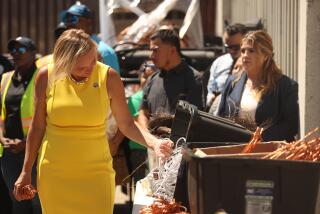Astronomers Win Latest Fight to Keep City Street Lights Yellow
- Share via
In a temporary victory for astronomers, the San Diego City Council on Monday rejected a proposal to replace some of the city’s yellow street lights with white ones--a plan that scientists warned could have seriously jeopardized local observatories’ research.
Despite the council members’ general dissatisfaction with the city’s street lights, they could not reach a majority agreement on either of two competing proposals dealing with the lights’ hue, number and location.
As a result, the city’s yellow, low-pressure sodium lights--which can be filtered from telescopes’ images but also distort colors and, some argue, insufficiently illuminate high-crime areas--will remain in place.
However, Mayor Maureen O’Connor and other council members predicted that the issue, which has been debated by the council periodically over the past decade, will be back later this year.
Already having deferred the lighting decision several times this spring, the council got bogged down Monday in a debate that was the rhetorical equivalent of a cloud passing over the Mt. Palomar and Mt. Laguna observatories.
The confusing blur of competing cost estimates, complex criteria for deciding which areas might get new white lights and the varying theories about how to appease astronomers while simultaneously enhancing street lighting in high-crime neighborhoods left the issue as murky and dark as critics contend the yellow low-sodium lights leave many city blocks.
Seeking to fashion a compromise between the astronomers and those who favor white lights on both aesthetic and crime-reduction grounds, Councilman John Hartley proposed that the yellow lights be replaced downtown and in high-crime areas south of Interstate 8.
Based on price estimates provided by the city manager’s office, that plan would have cost about half a million dollars next year.
By shielding the white lights to minimize their “sky glow” and more aggressively enforcing a city light pollution law, the new lighting would have little impact on the observatories, Hartley contended.
But Councilman Bob Filner complained that Hartley’s plan would have excluded many high-crime communities and could cost San Diego “millions and millions of dollars” as residents in the northern half of the city and other areas also pressed for white street lights.
As an alternative, Filner proposed a pilot project in which higher wattage street lights, placed closer together, would be tested in two high-crime neighborhoods to assess their impact.
Siding with Filner, O’Connor argued that the city needed “more street lights, not different lights.”
In the end, however, both Hartley’s and Filner’s proposals failed by 5-4 votes, with Councilwoman Abbe Wolfsheimer, who questioned whether the city could afford either plan in a year when it faces the prospect of multimillion-dollar budget cuts, voting against both.
O’Connor, Filner and Councilwomen Valerie Stallings and Judy McCarty joined Wolfsheimer in defeating Hartley’s recommendation.
But, in the first step toward the next round of debate, the council also voted unanimously to refer the question of adding street lights, which cost about $3,000 each, to a council committee for review.
More to Read
Sign up for Essential California
The most important California stories and recommendations in your inbox every morning.
You may occasionally receive promotional content from the Los Angeles Times.










